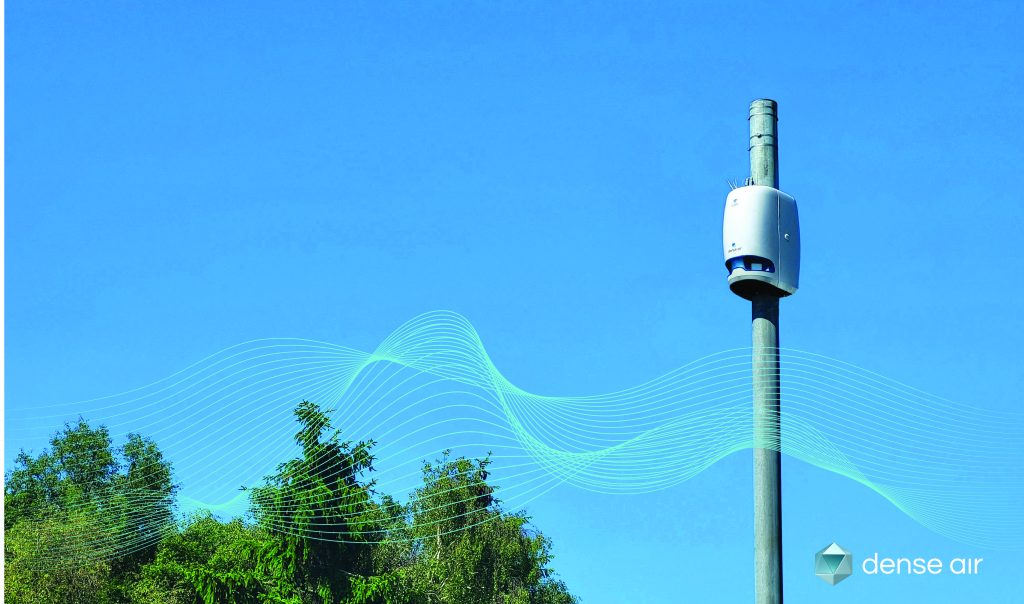About the deployment
Dense Air is pioneering the use of Split 6 fronthaul and smart antenna technology for the scaled deployment of small cell clusters to support or infill existing holes in carrier networks, or to provide densified, dedicated private mobile coverage, enabling a range of use cases and applications.
The development of streetCell was supported through the UK Government’s Future RAN competition. Dense Air led the development, design and trial deployment of small cell clusters which would enhance network resilience and robustness – this project was called CoMP-ORAN, which stands for Coordinated Multipoint – Open Radio Access Networks.
One key use case for Split 6, an architecture championed by Small Cell Forum (SCF), is in high performance scenarios such as Connected Automated Vehicles (CAV). Using smart antenna technologies like CoMP, Dense Air’s small cell cluster design reduces the frequency of handover, providing contiguous connectivity to the vehicles, minimising the chance of data drops or disconnect.
Trial deployments and field testing happened in both Millbrook Proving Ground in Bedfordshire and at Teesside International Airport in the north of England. However, the technology being developed is versatile and applicable to various global markets. After gaining Federal Communications Commission (FCC) approval in 2023, streetCell is currently being deployed at scale across the United States.
The impact
The development of streetCell brought together several SCF members – Dense Air, Radisys and Airspan – not only to design and develop the hardware solution but also to deploy an effective end-to-end Open RAN solution, built on industry partnerships. This model, proven at the Millbrook trial, can now be offered as a complete neutral host solution where each cell within a cluster using licensed spectrum can provide densified carrier services or private secure connectivity. Although at Millbrook the use case centred on automotive, Dense Air is now deploying for enterprise and industry and working closely with a number of local government bodies, utilising existing street infrastructure to cost effectivity bring mobile service to areas in need of service.
This video illustrates a vehicle (represented by the blue dot) driving around the city course at Millbrook Proving Ground in Bedfordshire at the Cenex Expo event in September 2023. The dynamic white lines illustrate the constant connection to the vehicle from multiple cells within this cluster of 5 cells (represented by the hexagon).
The technical details
CoMP takes lead from macro level Multi Input, Multi Output (MIMO) technologies, provides significant advantages, such as:
- Each streetCell can provide both 360-degree coverage, or multi directional sectorisation with adaptable beam patterns.
- Enables the remote optimization of streetCell clusters via a Radio Intelligent Controller (RIC) to the targeted coverage and capacity objectives.
- Multiple Transmit Receive Points (Multi TRP), designed for CoMP, maximise the gains from spatial diversity and spatial multiplexing.
- Compliments macro cells by providing additional in-fill.
- Improves deployment robustness.
- Removes the need for pre-deployment radio frequency (RF) design phase to consider antenna alignment / placement.
- Eliminates nulls in target coverage area and optimises cell footprint post deployment.
- Designed to support multi-sector 2×2 MIMO operation.

The outcome
To support new 5G use cases, the industry is required to become increasingly innovative in how to reduce cost while at the same time provide enhanced reliability. By augmenting the existing network, identifying, and targeting network weak spots, Dense Air has enabled carriers to tap into seamless, low-cost additional coverage and capacity through a scalable, flexible small cell deployment model.
Their use of Split 6 fronthaul and switch beam antenna significantly reduces the cost to deploy clusters of shared network infrastructure in supporting diversified use cases. This technology which is an integral aspect of their streetCell product line, initially tested and proven at UTAC Millbrook Proving Ground, has been implemented into Dense Air’s end to end As-a-Service solution with partners Radisys and EdgeQ, currently been deployed to support several CAV use cases across the United States.
This video provides an overview of the Dense Air small cell deployment at Millbrook Proving Ground in Bedfordshire.
To find out more about Dense Air’s solutions and as-a-service deployment model please contact: [email protected]
